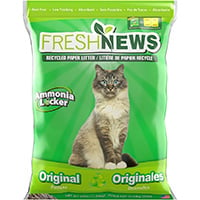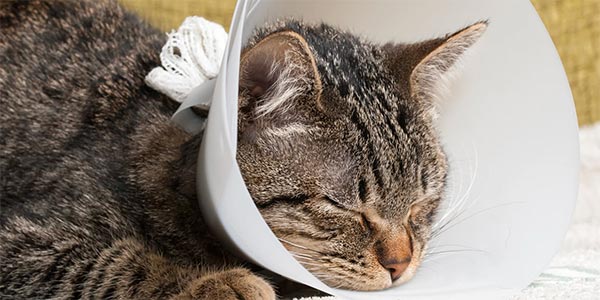 Depending on the procedure, it can be quite trying to have a cat go through surgery. Often, the “trying” part doesn’t end once your cat has left the hospital, as their post-operative recovery period at home can often be equally difficult. This article will help to make it easier on you both.
Depending on the procedure, it can be quite trying to have a cat go through surgery. Often, the “trying” part doesn’t end once your cat has left the hospital, as their post-operative recovery period at home can often be equally difficult. This article will help to make it easier on you both.
Whether your cat’s just been spayed/neutered, had a cat bite abscess, had a broken bone surgically repaired, or had abdominal surgery of their digestive tract or urinary bladder, it’s important that they’re given the time, space, and environment to rest and heal.
Thankfully for you both, the typical time necessary for post-op exercise restriction and/or confinement isn’t usually too long.
- Skin and soft-tissue surgical procedures: usually ~10–14 days
- Orthopedic surgical procedures: usually ~6–8 weeks
And while this may seem like an eternity, and there may be times when you’ll want to give up and let your cat get back to being a cat, I implore you to see it through. The complications that can arise after certain procedures if you don’t properly limit your cat’s movement can be far more time-consuming (and expensive) than the original surgical procedure — and they can sometimes even have catastrophic consequences.
Below are some general guidelines and tips to help you and your kitty get through their post-op recovery period flawlessly.
Potential Problems After Your Cat’s Surgery
Regardless of the surgery, you’ll need to keep your cat inside for their post-op recovery period. And even indoor cats have to avoid running and jumping in order to have a trouble-free recovery. While ordinarily, you want to give your cat plenty of perches and places to run, play, and stretch their legs, running and jumping during their post-op recovery phase could result in any of the following complications:
- Hitting something or falling in their disoriented state
- Loosening their skin stitches or sutures, which will delay skin healing
- Loosening or causing failure of internal sutures or closures, which can cause bleeding or even leakage of bacteria or urine into the abdomen
- Pulling off bandages or even slipping bandages into a position that could cause more damage or pain
- Causing a bone plate, pin, or screw to move or otherwise not heal correctly
- Other problems
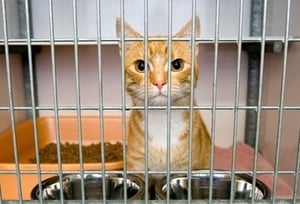 Best Places to Put a Cat After Surgery
Best Places to Put a Cat After Surgery
In preparation for your cat’s return home after surgery, you should set up a comfortable post-op recovery space that will help control your cat’s physical activity. Below are some suggested spaces, which will vary depending on your space, your cat, and the type of procedure they had.
- Large Carrier (Plastic Dog Crate): Many people have good success using a large, plastic,
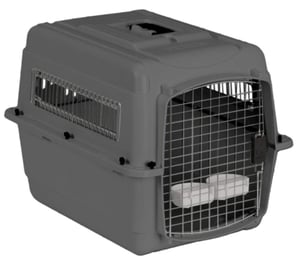 “airplane-style” dog crate for their cat’s post-op recovery space. These crates often have more than enough room for a bed where a cat can lounge and relax, but not get into too much trouble. A large enough crate should provide space for their litter box and food/water.
“airplane-style” dog crate for their cat’s post-op recovery space. These crates often have more than enough room for a bed where a cat can lounge and relax, but not get into too much trouble. A large enough crate should provide space for their litter box and food/water.
Even though you may have to spend some money to get a suitable crate (unless you know where to borrow one), it’s likely to be far less money than you’d have to spend on complications due to incorrect exercise restriction.
This PetMate Sky Kennel allows your cat ample room to recoup and also doubles as a crate that can be used in the cargo area of an airplane. The 360-degree wire ventilation windows surrounding the kennel allow for better visibility and fresh air for your cat. - Small Bathroom or Laundry Room: If a large kennel isn’t possible or practical, you can place your cat in a small bathroom or laundry room. However, there will likely be surfaces — anything from a windowsill or countertop, to a toilet or washing machine — that your cat may try to jump on.
And even that amount of jumping could pose risks, depending on the procedure your cat had. Plus you’ll need to cat-proof the room — taking special care to remove or block access to trash cans, medications, detergents, and other dangerous items. Check out our Top 10 Cat Proofing Tips for a more complete list. 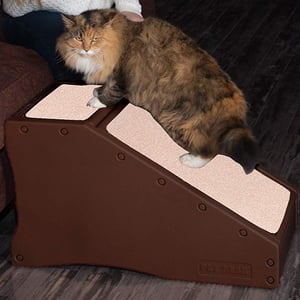 Bedroom: Similar to the bathroom or laundry room, a small bedroom might be a good option in certain situations. But also similar to a bathroom or laundry room, you’ll need to cat-proof the room and be aware of the potential for your cat jumping on the bed or another piece of furniture.
Bedroom: Similar to the bathroom or laundry room, a small bedroom might be a good option in certain situations. But also similar to a bathroom or laundry room, you’ll need to cat-proof the room and be aware of the potential for your cat jumping on the bed or another piece of furniture.
If moving the furniture out of the room isn’t practical, you may want to add pet stairs or a pet ramp next to the furniture so your cat can get up and down without having to jump. The Pet Gear stair and ramp combination (see inset photo) has carpet and a gentle slope, making it easier for your cat to get on the bed or couch.- With Your Vet: In certain situations where exercise restriction is extremely important, and proves too difficult in your home, ask your veterinarian or local veterinary ER if there are “medical boarding” options available. In some situations, this might be the best option to take. It’s especially helpful if you can visit your cat daily and they won’t be too stressed in a hospital environment.
Questions? If you would like to speak with a veterinarian about your cat's post-surgical recovery, Click here
The Best Post-Op Litter: Providing for Your Cat’s Basic Needs After Surgery
Your vet will give you detailed post-op instructions to follow about food, water, and your cat’s litter box needs based on the specific procedure your cat had.
Depending on the type of procedure your cat had, especially the presence of any skin stitches or bandages, it might be wise (and often recommended) to switch from your cat’s regular clay or other type of litter to one that’s less likely to get caught in their wounds and bandages.
Often the best type of litter for a cat with skin sutures or bandages is a shredded or pelleted paper-based litter. You can usually shred regular printer paper in a paper shredder (but always remember to turn off the shredder or unplug it to avoid accidents), or tear up newspaper or paper towels to put in a litter box.
Since none of these are particularly absorbent, it’s often a good idea to put an absorbent pee pad on the bottom of the litter box and then put shredded paper litter over top.
Or, if you’d rather not deal with shredding paper yourself, try the pelleted recycled paper litter options, like Fresh News.
Nursing Care for Your Cat After Surgery
Your vet will give you detailed post-op instructions about necessary “nursing care” your cat will need following their procedure and their post-op recovery phase. Here are some things you can expect to be part of the post-op care.
- Rest: Your cat will be groggy until the anesthesia wears off. Let them rest as much as possible, but continue to check on them throughout the day to make sure they're comfortable and recovering normally (e.g., steadily getting their energy back and waking up from their sedative and anesthetic medications, no abnormal bleeding or swelling, regaining their appetite, etc.).
- Medication: If your cat has gone home with any medications (or prescriptions for medications), it’s important to give them at the time and amount directed by your veterinarian, whether those medications are to help combat pain, infection, or anything else. If you have any problems giving the medications, or any questions or concerns about giving them, check with your vet. But never stop giving medications early without first discussing with your vet. (Need some tips on How to Pill Your Cat? Check out this article and the video below.) Failure to stick with the advised medication schedule could result in avoidable pain for your cat, antibiotic-resistant bacterial infections, and other problems.
- E-Collar/Cone: That dreaded “cone of shame” really is important. If you’ve ever been licked by a cat, you’ll know how rough their tongue can be. If that tongue is allowed to lick the incision or surgical site, it will heal less quickly and could become infected.
The E-collar helps prevent your cat from accidentally harming themselves, even though it’s inconvenient (and yes, a little humiliating for kitty). Learn how to desensitize your cat to wearing an Elizabethan collar, as well as suggestions on cones and post-surgery recovery suits. - Inspect the Incision: If your cat has an incision, check on it in the morning and again at night. It may be red and swollen for the first day or so, but continued redness, swelling, or seepage should be cause for concern. Check with your vet if you think the wound isn’t healing properly.
- Clean the Drains: Cat bite abscesses and some other surgeries may require the placement of surgical drains: small rubber tubes or pieces of surgical fabric that allow fluid to drain out. It’s important that you inspect and, if directed by your vet, clean the drains regularly.
- Follow-Up Check-Ins: There are often recheck vet visits necessary following surgical procedures. Sometimes it’s to remove drains and/or skin sutures or replace a bandage. Sometimes it’s to recheck blood tests, urine tests, or X-rays. Other times it’s just to repeat a physical exam to make sure everything is healing properly. Either way, these recheck exams are important to your cat’s complete recovery and continued health. Don’t skip them without first checking with your vet.
Your Vet Is There to Help You and Your Cat
You and your cat will likely have gone through a lot with their surgery… both in terms of the costs and logistics for you, as well as the actual anesthesia and surgery for your cat. The way you care for and nurse your cat in their “post-op period” can have as big an impact on the success of their recovery as the skill of the surgeon who performed the procedure.
So to help ensure the fastest, most complete, and least stressful recovery for your cat, please make sure to discuss their specific post-op recovery, recheck instructions with the veterinary team, and follow those instructions.
And if you have any questions or concerns, at any point, your vet or their staff will be happy to help you out. If necessary, your vet may even be able to provide you with certain medications to help reduce your cat’s “cabin fever” and make both of your lives that much easier.
When we vets say, “Don’t hesitate to call if you’ve got problems or concerns” we really mean it. We’d rather help you with your questions and concerns early on than tend to avoidable post-op complications later. When in doubt… call. After all, you both have the same goals… the quickest, smoothest, most trouble-free recovery for your cat.



